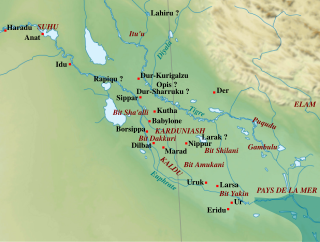Top Qs
Timeline
Chat
Perspective
Bit-Amukkani
Ancient Chaldean tribe From Wikipedia, the free encyclopedia
Remove ads
Bit-Amukani (in the Aramaic Assur Ostracon ʾwkn; Assyrian mA-muk-ka-nu; Babylonian diBit U-ka-a-ni, diU-ka-nu; lit. House of Amukani) was a tribe, proto-state founded by Chaldeans in southern Mesopotamia which stretched from southeast of Nippur to the area of Uruk.[1] It is considered[by whom?] to have been one of the most powerful Chaldean tribes, next to Bīt-Iakin and Bīt-Dakkūri.

As early as 732 BCE, it was ruled by prince Ukinzer (also known as Mukin-zeri or Nabu-mukin-zeri) who became a king of Babylon in 732 BCE instead of Nabu-shum-ukin II whom he superseded.[2] Later, Tiglath-pileser III devastated Bit-Amukani for the second time and defeated Mukin-zeri.[2] Shalmaneser III (856-824) inscriptions note that two Chaldean leaders (Mušallim-Marduk of Bīt-Amukāni and Adīnu of Bīt-Dakkūri) carried silver, gold, tin, bronze, elephant tusks, elephant skins, ebony and sissoowood (or meskannu wood) as a tribute to the King of Assyria.
Though unconfirmed, the economy of Bīt-Amūkāni probably relied on producing dates.
Tiglath-pileser III described his genocide of Bit-Amukani with the words: "the land Bit-Amukani I threshed as with a threshing instrument. I took all of its people (and) its property to Assyria." Although Tiglath-pileser III's writings testify about conflict with Bīt-Amūkāni, Bīt-Amūkāni never went extinct but actually remained important through later Babylonian history.
Sennacherib's inscriptions note that Bit-Amukani consisted of 39 walled cities and 350 villages.[3] Its capital was Sapia (Assyrian Sapīya or Šapīya).
Remove ads
List of Bīt-Amūkāni leaders
Remove ads
References
Wikiwand - on
Seamless Wikipedia browsing. On steroids.
Remove ads
